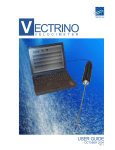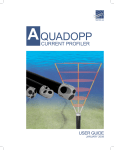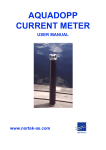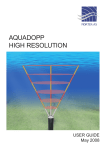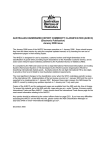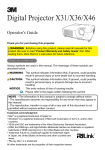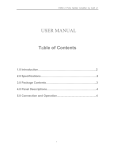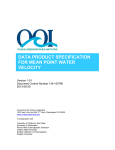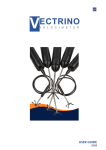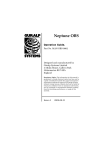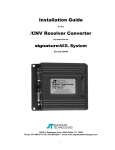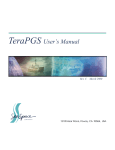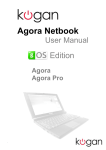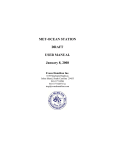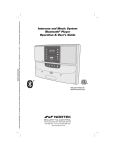Download QUADOPP - Ocean Networks Canada
Transcript
A QUADOPP DEEP WATER CURRENT METER USER GUIDE NOVEMBER 2004 DEEP WATER AQUADOPP Copyright © Nortek AS 2004. Ê November 2004. All rights reserved. This document may not – in whole or in part – be copied, photocopied, translated, converted or reduced to any electronic medium or machine-readable form without prior consent in writing from Nortek AS. Every effort has been made to ensure the accuracy of this manual. However, Nortek AS makes no warranties with respect to this documentation and disclaims any implied warranties of merchantability and fitness for a particular purpose. Nortek shall not be liable for any errors or for incidental or consequential damages in connection with the furnishing, performance or use of this manual or the examples herein. Nortek AS reserves the right to amend any of the information given in this manual in order to take account of new developments. Microsoft, ActiveX, Windows, Windows NT, Win32 are either registered trademarks or trademarks of Microsoft Corporation in the United States and/or other countries. Other product names, logos, designs, titles, words or phrases mentioned within this publication may be trademarks, servicemarks, or tradenames of Nortek AS or other entities and may be registered in certain jurisdictions including internationally. Nortek AS, Vangkroken 2, NO-1351 RUD, Norway. Tel: +47 6717 4500 • Fax: +47 6713 6770 • e-mail: [email protected] • www.nortek.no 4 User manual Software updates and technical support Find us on the world wide web: www.nortek-as.com, www.nortek.no Here you will find software updates and technical support. Your Feedback is appreciated If you find errors, misspelled words, omissions or sections poorly explained, please do not hesitate to contact us and tell us about it at: [email protected] We appreciate your comments and your fellow users will as well. Nortek Forum Support If you have comments, application tips, suggestions to improvements, etc. that you think will be of general interest you should register on Nortek’s Forums at www.nortek-as.com/cgi-bin/ib/ikonboard.cgi and post your message there. The Forums also offer a great opportunity to share your experience using Nortek sensors with other users around the world, and to learn from their experience. Communicating with us If you need more information, support or other assistance from us, do not hesitate to contact us: Nortek AS Vangkroken 2 NO-1351 RUD, Norway Phone: +47 6717 4500, Fax: +47 6713 6770 e-mail: [email protected] Doc. No: N3009-100 • Revision F • 11.2004 DEEP WATER AQUADOPP 5 User Guide DETAILS The Table of Contents CHAPTER 1 Introduction...................................................................................................................... 9 Getting Started..................................................................................................................... 9 Warranty ............................................................................................................................ 10 CHAPTER 2 Main Data ........................................................................................................................ 11 Weight and Outline Dimensions........................................................................................ 11 Power.................................................................................................................................. 11 Environmental ................................................................................................................... 12 Sensors ............................................................................................................................... 12 Temperature (thermistor embedded in head) .................................................................... 12 Compass (flux gate with liquid tilt) ................................................................................... 12 Tilt (liquid level) ................................................................................................................ 12 Pressure (piezoresistive) .................................................................................................... 12 Data Communication......................................................................................................... 12 Software (DEEP WATER AQUADOPP) ...................................................................................... 12 Data Recording .................................................................................................................. 12 Water Velocity Measurements........................................................................................... 13 Measurement Area............................................................................................................. 13 Doppler uncertainty (noise) ............................................................................................... 13 Echo Intensity ................................................................................................................... 13 Material ............................................................................................................................. 13 CHAPTER 3 Technical Description.................................................................................................. 15 The Sensor head................................................................................................................. 15 Electronics Module ............................................................................................................ 15 Compass............................................................................................................................. 16 Internal Battery Pack......................................................................................................... 16 Battery Pack Voltage and Remaining Capacity ................................................................ 16 Power & Communication Cable ........................................................................................ 16 Cable Wiring...................................................................................................................... 16 Power Requirements Using RS 422 ................................................................................... 16 Doc. No: N3009-100 • Revision F • 11.2004 6 Contents Functional Description ...................................................................................................... 18 Modes of Operation ........................................................................................................... 18 Using the Doppler Effect .................................................................................................. 19 Doppler Beams .................................................................................................................. 19 Coordinate Systems ........................................................................................................... 20 Attitude Correction............................................................................................................ 21 Velocity Uncertainty ......................................................................................................... 21 Maximum Range to the Measurement Cell ...................................................................... 22 CHAPTER 4 Preparation ..................................................................................................................... 23 Initial Steps ........................................................................................................................ 23 Install the Aquadopp software on a PC ............................................................................ 25 Run a Functional Test ........................................................................................................ 25 Test the recorder function.................................................................................................. 26 Mounting Guidelines ......................................................................................................... 26 Flow Disturbance............................................................................................................... 26 Other Mounting Considerations ........................................................................................ 27 Using Long Cables............................................................................................................. 27 Changing the Baud Rate.................................................................................................... 27 CHAPTER 5 Operation ........................................................................................................................ 29 Introduction to the Main Menu.......................................................................................... 29 Data collection ................................................................................................................... 30 Deployment Planning ........................................................................................................ 31 Start Recorder Deployment ............................................................................................... 33 Setting the Time and Using Delayed Start-up................................................................... 34 Verifying Operation with a Radio ..................................................................................... 34 Stop recorder Deployment ................................................................................................. 34 Recording Data Internally as a Backup............................................................................. 35 Getting Data out of the Aquadopp .................................................................................... 35 Finish Operations............................................................................................................... 36 Erasing Recorded Data ...................................................................................................... 36 Operational Concerns ........................................................................................................ 36 My Data Doesn’t Look Right ............................................................................................ 36 Boundaries ......................................................................................................................... 36 Sidelobes ............................................................................................................................ 37 Grounding Problems.......................................................................................................... 38 Mooring Tilt....................................................................................................................... 38 Mooring Vibration ............................................................................................................. 38 Troubleshooting ................................................................................................................. 39 Simple Problems ................................................................................................................ 39 Problems Detecting the Instrument on the Serial Port...................................................... 39 Serial Loop-back Test........................................................................................................ 39 CHAPTER 6 Maintenance ................................................................................................................... 41 Preventive Maintenance .................................................................................................... 41 Cleaning............................................................................................................................. 41 Replacing the Desiccant .................................................................................................... 41 Installing/Changing Batteries ........................................................................................... 42 Doc. No: N3009-100 • Revision F • 11.2004 DEEP WATER AQUADOPP 7 User Guide To connect the Battery Pack or to Install a New One: ...................................................... 42 Corrective Maintenance .................................................................................................... 43 APPENDIX 1 Mechanical Drawings .................................................................................................. 45 APPENDIX 2 Returning Aquadopp for Repair ............................................................................... 47 Doc. No: N3009-100 • Revision F • 11.2004 8 Contents Doc. No: N3009-100 • Revision F • 11.2004 DEEP WATER AQUADOPP 9 User Guide CHAPTER 1 Introduction Thank you for purchasing a NORTEK Deep water Aquadopp Current Meter. The Deep water Aquadopp has been designed to give you many years of safe, reliable service. The Aquadopp uses the Doppler effect to measure current velocity by transmitting a short pulse of sound, listening to its echo and measuring the change in pitch or frequency of the echo. You hear the Doppler effect whenever a train passes by – the change in pitch you hear tells you how fast the train is moving. Getting Started To get you up and running: 1 Before you start using the Aquadopp, please familiarize yourself with the Current Meter by reading Chapters 2 and 3 of this user guide. The 2000-m and the 6000-m versions share a common look However, they differ in the colour of the head and the material used for the canister. 2 Perform reception control and functional test of the Aquadopp according to procedures in Chapter 4. 3 Start using the Aquadopp according to procedures in Chapter 5. 4 Perform regular maintenance according to procedures in Chapter 6. Doc. No: N3009-100 • Revision F • 11.2004 10 CHAPTER 1 Introduction Warranty In order to stay up-to-date and receive news and tips from the factory you should register at our web site. Use the Internet and go to http://www.nortek-as.com/ newsletter.php. Enter your name, e-mail address and topics of interest. We also recommend our User Forum where you may post questions and discuss with other people in the oceanographic community. To get to the User Forum enter http://www.nortek-as.com and click on Forum. If you have no internet access or, if you – for any other reason – prefer traditional mail or telefax, you may fill in and return the registration part of the warranty sheet accompanying your Nortek product. Nortek AS grants a one year limited warranty that extends to all parts and labour and covers any malfunction that is due to poor workmanship or due to errors in the manufacturing process. The warranty does not cover shortcomings that are due to design, nor does it cover any form of consequential damages as a result of errors in the measurements. In the unlikely event of trouble with your Nortek product, first try to identify the problem by consulting the documentation accompanying your Nortek product. If you need further assistance when trying to identify the problem, please contact your local Nortek representative or the factory. Please make sure you receive a Return Merchandise Authorization (RMA) before any product or module is returned. An RMA can be obtained using our e-mail address: [email protected] or our Fax No.: +47 6713 6770. See also Appendix 2. Doc. No: N3009-100 • Revision F • 11.2004 DEEP WATER AQUADOPP 11 User Guide CHAPTER 2 Main Data This chapter provides the technical specifications of your Deep water Aquadopp Weight and Outline Dimensions Transport weight: 40 kg (transport box, all inclusive) Transport box dimensions: 0.70 × 0.38 × 0.11 [m] (w×l×h) Weight in air: 4.4 kg (2000-m version), 8 kg (6000-m standard tube length ver- sion) Weight in water: 1.2 kg (2000-m version), 4.8 kg (6000-m version) Length: 597 mm (2000-m version), 636 mm (6000-m version), 756 mm (extended 6000 m version) Diameter: 84 mm Power DC Input: 9–16 VDC (6000 m extended tube version has no DC input) Battery DC-input: Nominal voltage: 13.5–18V Absolute maximum DC input voltage: 18.6V Peak current: 2A @ 12 VDC Max. average power consumption (1 Hz): 0.2–1.0 W Average consumption (0.02 Hz): 0.2 W Average consumption (0.002 Hz): 0.02 W Sleep consumption: 0.0013 W Battery capacity: 50 Wh (extended 6000 m version has two battery packs) New battery voltage: 13.5 V Doc. No: N3009-100 • Revision F • 11.2004 12 CHAPTER 2 Main Data Environmental Operating temperature: –5 °C to +45 °C Storage temperature: –15 °C to 60 °C Shock and vibration: IEC 721–3–2 Pressure rating: 0–2000 m/0–6000 m Sensors Temperature (thermistor embedded in head) Range: –4 °C to +40 °C Accuracy/Resolution: 0.1 °C/0.01 °C Time response: Approximately 10 min. Compass (flux gate with liquid tilt) Maximum tilt: 30° Accuracy/Resolution: 2°/0.1° for tilt <20° Tilt (liquid level) Accuracy/Resolution: 0.2°/0.1° for tilt <20° Up or down: Automatic detect Pressure (piezoresistive) Range: 0–2000/6000 m (standard) Accuracy/Resolution: 0.25% / Better than 0.005% of full scale per sample Data Communication I/0: RS 232 or RS 422 Baud rate: 300–115200 (user setting) User control: Handled via Win®32 software, ActiveX® function calls, or direct commands with binary or ASCII data output. Software (DEEP WATER AQUADOPP) Operating systems: Windows® 2000, Windows® XP Functions: Deployment planning, start with alarm, data retrieval, ASCII conver- sion. Online data collection and graphical display. Test modes. Data Recording Capacity (standard): 9 MB, expandable to 33 MB, 89, or 161 MB Data record (memory in bytes): 40 Diagnostic record (memory in bytes): 40 Doc. No: N3009-100 • Revision F • 11.2004 DEEP WATER AQUADOPP 13 User Guide Water Velocity Measurements Range: ±3 m/s Accuracy: 1% of measured value ±0.5 cm/s Max sampling rate (output): 1 Hz Internal sampling rate: 23 Hz Measurement Area Measurement cell size: 0.75 m Measurement cell position: 0.35–5.0 m (user selectable) Number of cells: 1 Default position (along beam): 0.35–1.85 m Doppler Uncertainty (noise) Typical uncertainty for default configurations: 0.5–1.0 cm/s Uncertainty in U, V at 1 Hz sampling rate: 1.5 cm/s Echo Intensity Acoustic frequency: 2 MHz Resolution: 0.45 dB Dynamic range: 90 dB Material Standard model: 2000-m: Delrin and polyurethane plastics with titanium screws 6000 m: Delrin and titanium Doc. No: N3009-100 • Revision F • 11.2004 14 CHAPTER 2 Main Data Doc. No: N3009-100 • Revision F • 11.2004 DEEP WATER AQUADOPP 15 User Guide CHAPTER 3 Technical Description Transducers The Sensor Head Head Configurations. The sensor head contains three acoustic transducers and a pressure sensor, all visible from the outside. The sensor head also holds the following sensors: • Tilt sensor. The tilt sensor is on a small round daughter board attached to Pressure sensor the head, inside the case. The tilt sensor orientation is set in accordance with the system orientation during normal operation. The standard Aquadopp is designed for vertical orientation. Tilt sensors in heads designed for horizontal orientations will be mounted at right angles. The tilt sensor can be inverted 180 degrees – you can use it pointing up or down. • Temperature sensor. The temperature sensor, standard on all Aquadopps, is mounted internally in the sensor head. • Pressure sensor. The pressure sensor is mounted in the Aquadopp sensor head. Electronics Module The electronics module is a single board that holds the power transmitter, analog and digital signal processing, power conditioning and the standard data recorder. Doc. No: N3009-100 • Revision F • 11.2004 16 CHAPTER 3 Technical Description Compass The compass measures the earth’s magnetic field. Combined with the tilt sensor on the head, the compass enables the Aquadopp to obtain the heading. This data enables the Aquadopp to convert velocity measurements to Earth coordinates. Without a compass, the Aquadopp still measures tilt. Internal Battery Pack The internal battery pack is located inside the pressure case, and enables autonomous deployments of up to a year. It also provides backup power in the event of failure of the external supply. Standard alkaline battery packs use 18 AA cell batteries at a nominal starting voltage of 13.5VDC. Battery Pack Voltage and Remaining Capacity NORTEK alkaline battery packs start life at a voltage of 13.5 VDC or higher. The voltage of alkaline batteries falls quickly at the beginning, slowly during most of its life, then again quickly at the end. Thus a 13.5 VDC battery pack will spend the largest part of its life somewhere in a voltage range of 10.5–12.5 VDC. Power & Communication Cable Note! The 6000 m extended tube version cannot be used with external DC. This version is equipped with double battery and the connection is used to connect to the other battery rather than external DC. This enables you to supply external DC power (9–16 V) and to connect an external computer to the Aquadopp via 2-way serial communication. Cable Wiring The Aquadopp comes standard with an 8-conductor RS 232 cable, but it can be ordered with an 8-conductor cable for use with RS 422 communication. The tables list the pin assignments for cable wiring options offered. The Aquadopp power and battery lines are diode protected, so you don’t have to worry about wiring the Aquadopp power backwards – this will not damage your instrument. Power Requirements Using RS 422 Caution! Be sure to use silicone spray and not silicone grease on the dummy plugs and the cables. The use of silicone grease on these may cause permanent damage to the system! Silicone grease should be applied to the O-rings only. RS 422 power requirements are higher than those of RS 232, and harder to predict. RS 422 increases sleep power consumption to at least 60 mW and it increases operational power consumption by 60–250 mW, depending on how the RS 232/RS 422 converter is terminated. Since RS 422 is normally used in real time operations, you may supply the additional required power from an external power source. Doc. No: N3009-100 • Revision F • 11.2004 DEEP WATER AQUADOPP 17 User Guide Underwater connector Pin number Wire color Termination Purpose 3 Black RS232 Tx 4 White RS232 Rx 5 Black Ground 6 White/purple Analog Z 7 Black Analog X 8 White/orange Analog Y 1 Black Power ground 2 White Power positive Screen Bare Ground Pin numbers, looking at the pins Pins twisted pair twisted pair Description 2 9-pin Dsub, female 3 5 F Facing sockets Red wire twisted pair twisted pair Green wire Yellow wire Black wire Red wire 3 bare wires for grounds, connected internally to power ground RS 232 cable with option for analogue outputs Table 3: RS232 Cable with analog inputs Underwater connector Pin number Pin numbers, looking at the pins Wire color Termination Purpose 3 Black RS232 Tx 4 White RS232 Rx 5 Black RS232 ground 6 White/purple power output 7 Black analogue input 2 8 White/orange analogue input 1 1 Black power ground 2 White power positive Screen Bare ground Pins twisted pair 2 3 5 twisted pair Description 9-pin Dsub, female F Facing sockets Red wire Green wire twisted pair Yellow wire Black wire twisted pair Red wire 3 bare wires for grounds, connected internally to power ground RS 232 cable with option for analogue inputs Doc. No: N3009-100 • Revision F • 11.2004 18 CHAPTER 3 Technical Description Underwater connector Pin number Pin numbers, looking at the pins Wire color Termination Purpose 3 Black RS422 Tx+ 4 White RS422 Tx- 7 Black RS422 Rx- 8 White/orange RS422 Rx+ 5 Black Synch out 6 White/purple Synch in 1 Black Power ground 2 White Power positive Screen Bare Power ground Pins twisted pair 2 twisted pair 1 3 Description 9-pin Dsub, female 9 twisted pair Black wire twisted pair black wire Facing sockets Green wire Red wire three ground lines through shield Wiring of 8-conductor cable for RS422 communication. Tx and Rx refer to Aquadopp and not the PC! Functional Description This section briefly describes some of the underlying principles that control the operation and application of the Aquadopp Current meter. Modes of Operation Tip! If you set the Aquadopp to collect data, remove power, then reapply power later, the Aquadopp will immediately resume data collection. Remember that the time may be lost. The Aquadopp has three different modes of operation: • Command Mode. An Aquadopp in command mode is powered up and ready to accept your instructions. If it gets no commands for about five minutes, it automatically powers down and goes into sleep mode. You cannot send commands directly to the Aquadopp. Instead, you must enter commands through the Aquadopp software. The Aquadopp software and hardware interact with each other using low-level binary data structures. This approach simplifies the design of the Aquadopp hardware and increases its overall reliability. • Data Acquisition Mode. The Aquadopp enters data acquisition mode when you click any of the Start commands (i.e. Start Recorder Deployment in the Aquadopp software. When you initiate a deployment sequence, the software converts your setup parameters into binary structures, downloads the structures to the Aquadopp and tells it to start data collection. Doc. No: N3009-100 • Revision F • 11.2004 DEEP WATER AQUADOPP 19 User Guide To get the instrument out of data collection mode, use one of the Stop commands in the Aquadopp software. You might notice that sending a break to an Aquadopp in data acquisition mode gets a response, but that data collection does not stop. The purpose of this design is to protect the system from stopping after an accidental break. • Power Down Mode. The Power Down Mode saves power during deploy- ments and prevents your battery from dissipating between deployments. The Aquadopp automatically powers down from command mode after about five minutes of inactivity. To conserve your battery when the Aquadopp is on the shelf, be sure it is not in data acquisition mode. Stop data collection using one of the Stop buttons before you store an Aquadopp Using the Doppler Effect You hear the Doppler effect whenever a train passes by – the change in pitch you hear tells you how fast the train is moving. The Aquadopp uses the Doppler effect to measure current velocity by transmitting a short pulse of sound, listening to its echo and measuring the change in pitch or frequency of the echo. There are many ways to measure the Doppler effect, each with its own advantages and drawbacks. NORTEK implements a narrow band auto covariance method, because this has been established as robust, reliable and accurate. Sound does not reflect from the water itself, but rather from particles suspended in the water. These particles are typically zoo plankton or suspended sediment. Long experience with Doppler current sensors tells us that the small particles the Aquadopp sees move on average at the same speed as the water – the velocity it measures is the velocity of the water. Doppler Beams Doppler current sensors use large transducers (relative to the wavelength of the sound) to obtain narrow acoustic beams. The Aquadopp’s beams have a beam width of 1.7°. Narrow beams are essential for obtaining good data. Doc. No: N3009-100 • Revision F • 11.2004 20 CHAPTER 3 Technical Description Measurement Cell Location Blanking is the time during which no measurement takes place, essentially to give the transducers time to settle after having emitted a pulse (the transducers are used as both transmitters and receivers), but it may also be used to position the measurement cell. The 75 cm dimension that applies to the transmit pulse and measurement cell is fixed by the Aquadopp soft ware, but you can adjust the blanking. Given the default 35 cm blanking, the centre of the measurement cell is located at 110 cm (=35+75) from the sensor head. 75 cm Transmit 35 cm Blanking 75 cm 75 cm Measurement cell Each beam measures velocity parallel to the beam and does not sense the velocity perpendicular to the beam at all. The Aquadopp senses the full 3D velocity with three beams, all pointing in different directions. If you assume the flow is uniform across the three beams, simple trigonometry is sufficient to compute the vertical velocity. The measurement cell is shaped like a triangle (see above Fig.). The triangular shape means that it is more sensitive to currents in the middle of the cell than at the extremes. The maximum extent of the cell is twice the length of the transmit pulse. Coordinate Systems The Aquadopp measures velocity components parallel to its three beams, or in beam coordinates, but it reports data in East, North and Up or ENU coordinates. To get to ENU components, it first converts the data to XYZ coordinates, an orthogonal coordinate system relative to the Aquadopp. The Aquadopp then uses its compass and tilt measurements to convert this velocity to components relative to the earth, or ENU coordinates. The coordinate systems are defined as follows: • In Beam coordinates, a positive velocity along beam 1 goes in the direction towards which the beam 1 points. • In XYZ coordinates, a positive velocity in the X-direction goes in the direc- tion of the X-axis arrow. • In ENU coordinates, a positive east velocity goes toward east. Doc. No: N3009-100 • Revision F • 11.2004 DEEP WATER AQUADOPP 21 User Guide Z Definition of the XYZ coordinate system for an Aquadopp deployed upright. The Z component is up, along the axis of the pressure case. If the Aquadopp is deployed upside down, the Z axis and Yaxis are reversed relative to the pressure case. Y X Pressure sensor Please contact NORTEK if you want detailed information about the coordinate transformation equations used in the Aquadopp. Attitude Correction Typical moorings allow the Aquadopp to tilt and rotate freely. It measures its tilt and heading and uses this information to correct the data to true earth coordinates. Because the compass uses energy, the Aquadopp reads heading only as often as it needs to. In a near-surface mooring, it will read the compass more often than it would on a fixed bottom mount. Velocity Uncertainty The Aquadopp velocity is an average of many velocity estimates (called pings). The uncertainty of each ping is dominated by the short-term error. We reduce the measurement uncertainty by averaging together many pings. There is a limit to how much you can reduce your uncertainty. We call this limit the long-term bias. Note: The Deep water Aquadopp software predicts the instrumental error only. In many situations, environmental turbulence will dominate the short term velocity fluctuations. The long-term bias depends on internal signal processing, the filters, and by your beam geometry. The long-term bias in the Aquadopp is typically a fraction of 1 cm/s. The Aquadopp software predicts errors based on the short-term error of a single ping and the number of pings averaged together. The short term error of a single ping depends on the size of the transmit pulse and the measurement volume, and it depends on the beam geometry. Beams parallel to the dominant flow will have smaller short-term errors than beams at a steep angle relative to the flow. Averaging multiple pings reduces errors according to the formula: Vmean in which together. = Vping N is the standard deviation and N is the number pings you average Doc. No: N3009-100 • Revision F • 11.2004 22 CHAPTER 3 Technical Description In turbulent flow such as boundary layers, your data collection strategy should take into account the nature and the time scales of the environmental fluctuations. A rough rule of thumb in boundary layers is that the RMS turbulent velocity is 10 % of the mean velocity. If, for example, your mean velocity is 1 m/s, you could estimate turbulent fluctuations to be 10 cm/s. Obtaining 1 cm/s RMS uncertainty would require at least 100 pings. Maximum Range to the Measurement Cell The Aquadopp software sets the default distance to the measurement cell at 0.35–1.1 m from the sensor head, but you can adjust the range out further. The figure shows how signal strength varies with range, based on the sonar equation. Signal strength varies with transmit power, backscatter strength and distance. If you know the signal strength at a given power level and a given range, you can use the figure to predict the signal strength you would have at a different power level and range. If you keep the same power level and change the range, follow the curve closest to the value you started with. If you change the power level, move up or down one curve for each power level (the curves are 6 dB apart). Measurement range vs. signal strength at 2 MHz. The “+” symbols show actual data from a river at power level 2. The noise floor is typically found at 20–30 counts. The range figure arbitrarily assigns 25 counts the value 0 dB. Because of the way we compute the signal strength, you can actually obtain good data at signal strengths a few dB below the noise floor. This means the noise floor gives you a conservative cutoff for good data. Doc. No: N3009-100 • Revision F • 11.2004 DEEP WATER AQUADOPP 23 User Guide CHAPTER 4 Preparation Initial Steps We strongly recommend that you carry out the following procedures to prepare your new Aquadopp for future successful operation: • Perform a reception control – see overleaf. • Install the internal battery pack, refer to Chapter 6 • Install the Aquadopp Software on a PC • Perform a functional test of your new Aquadopp • When you are ready to perform data acquisition, mount the Aquadopp ac- cording to guidelines provided in this chapter. Doc. No: N3009-100 • Revision F • 11.2004 24 CHAPTER 4 Preparation Please check that the following equipment is included in the delivery: 1 2 3 4 5 6 7 8 9 10 11 Transportation box Aquadopp current meter External power/signal cable NORTEK equipment storage box Packing list Aquadopp user manual Aquadopp software Warranty card Voltage transformer (110-230 VAC to 9-16 VDC) Internal battery pack Power cable Please contact NORTEK immediately if you find parts of the delivery are missing. Doc. No: N3009-100 • Revision F • 11.2004 DEEP WATER AQUADOPP 25 User Guide Install the Aquadopp software on a PC To install the software: 1 Insert the CD and run the Setup.exe file 2 Follow the on-screen instructions. Accept default settings. 3 If prompted to, restart your PC to finalize the installation process. Run a Functional Test To run a functional test: 1 Plug in the AC adaptor and connect the Aquadopp to the PC serial port. 2 Select Serial Port from the Communication menu to specify the port number to use. 3 Accept the default baud rate settings (9600 baud), which is also the default instrument baud rate. 4 Check the instrument communication and verify that the instrument is alive by activating the Terminal Emulator window and press the Send Break but- ton to send a BREAK signal over the serial port. A break causes the instrument to report an identification string. 5 Check the noise level of the instrument. Pinging in air should produce a sigTip! Diagnostics data give you the ability to obtain the in-situ noise floor of the instrument after it is deployed. nal strength (Amplitude) of 22–30 counts. This signal level is called the noise floor. When the instrument pings in air, the velocity measurements will be nothing but noise. Put the instrument in a bucket of water and observe the signal strength and the velocity. The signal strength should rise noticeably (the actual level depends on the size, shape and material of the bucket), and the velocity data should appear less noisy. 6 Check sensor readings. 7 Tilt and rotate the Aquadopp to verify that the readings make sense. 8 Temperature should be close to your room temperature, assuming the Aqua- dopp has been in the room for a while. 9 Pressure should be near zero. Check the pressure sensor in a bucket 50 cm deep, or put your mouth over the pressure sensor and blow to create a pressure of around 50 cm. 10 Battery voltage shall be greater than 13 VDC (new battery). Doc. No: N3009-100 • Revision F • 11.2004 26 CHAPTER 4 Preparation Test the Recorder Function Note: If you leave the Aquadopp collecting data, it will continue to run until the batteries are dead. Always make sure to stop data collection when testing is complete. This puts the Aquadopp into command mode and it will then enter into a sleep state (the lowest possible power) after 5 minutes of inactivity. You can test the recorder with the same setup as the above. Do as follows: 1 Start data collection with Test followed by Start With Recorder. 2 Write a name to use for the file you will record internally. 3 After a few minutes, stop the data collection. 4 Retrieve your data by clicking Deployment > Retrieve Data. 5 Convert it to ASCII by clicking Deployment > Data Conversion. 6 Review the collected data with an ASCII text editor (i.e. Notepad). Mounting Guidelines Tip: The best way to hold an Aquadopp to a fixed structure is to clamp it around its circumference. For mounting Aquadopps on a mooring line, NORTEK provides a fairing called the Aquafin that holds the Aquadopp and allows it to swivel freely around a mooring line to keep its beams oriented into undisturbed flow. Flow Disturbance The Aquadopp’s beam geometry is one of its innovative features. A standard current profiler is forced to use its vertically slanted beam geometry in order to obtain profiles. The Aquadopp gives you more flexibility in the beam geometry – this allows you to design your mooring to minimize disturbance caused by the mooring itself. Self-disturbance of flow is a chief source of data contamination with traditional current meters. A good example is a mooring that places the Aquadopp in a streamlined fin or torpedo can ensure that the beams always point into undisturbed flow. You can choose where to place your measurement volume to gain additional control over flow disturbance. The Aquafin – see www.nortek.no for more on this. For example, if you simply attach the Aquadopp directly to a rope or cable, the middle of the standard measurement cell position (about 110 cm) is more than 10 times the diameter of the Aquadopp. While this is acceptable according to a standard rule of thumb, you can increase the ratio by putting the cell even further out (up to 5 m). Keep in mind that increasing the distance to the measurement cell may require an increase in transmit power. Doc. No: N3009-100 • Revision F • 11.2004 DEEP WATER AQUADOPP 27 User Guide Other Mounting Considerations The Aquadopp has been designed for easy mounting and deployment. The following guidelines should give you the best possible data: • When mounting the Aquadopp near large obstructions (bridges, piers, walls, etc.), ensure that the acoustic beams do not “see” any obstructions. • Keep the Aquadopp away from magnetic materials. Consider the frame or cable holding the Aquadopp, and the structure it is mounted on. Nearby magnetic materials could cause the directional readings to be in error. If magnetic materials are near by, the best recommendation is to use XYZ coordinates, as the Aquadopp then do not use the compass. • Consider the effects large objects will have on the flow itself. A rough rule of thumb is that objects disturb the flow as far as 10 diameters away from the object. Flow disturbance is greatest directly downstream in the wake behind the object. Flow disturbance affects your measurements by changing the flow and by making it non-uniform across the Aquadopp’s beams. • All acoustic transducers must be submerged during data collection. Operat- ing with the transducers out of water will not cause damage, but your data will be meaningless. • The pressure sensor can handle pressure that is 1.5× its maximum reading. Using Long Cables RS232 data communication at 9600 baud will normally work fine for cables up to 50–100 m long, depending on the environment. If you want to run a longer cable, you can switch to RS422 by installing a kit you can get from NORTEK. You can also try using RS232 with longer cables by reducing the baud rate. Keep in mind that RS422 is a more reliable means of communication than RS232 – changing environmental conditions could cause RS232 communications to fail over a long wire without apparent reason. Changing the Baud Rate You may specify two separate baud rates for the Aquadopp. The primary baud rate setting applies to normal communication and data transfer. You can also set a secondary baud rate for data download and firmware upgrades (the Recorder/ Configuration baud rate). A higher baud rate speeds up large file transfers and is appropriate when you have a short serial cable and a relatively noise-free environment. Doc. No: N3009-100 • Revision F • 11.2004 28 CHAPTER 4 Preparation The standard baud rate is 9600, and we recommend that you use this baud rate unless you have a good reason to change it. Note! If data download is interrupted the Aquadopp may be left with a baud rate setting other than the one used for normal communication. When the software tries to establish communication in such cases, it may spend a few moments searching for the current baud rate. To change the baud rate and make it permanent, do the following: 1 Set up the Aquadopp and connect it to your computer. 2 Set the baud rate in Communication > Serial Port to the baud rate you prefer. Start a deployment, and then stop it. The last step makes the new baud rate permanent. If you remove power and reapply it, the Aquadopp will re-awake with the new baud rate. Doc. No: N3009-100 • Revision F • 11.2004 DEEP WATER AQUADOPP 29 User Guide CHAPTER 5 Operation The Aquadopp program is designed to aid in the planning, execution, recovery and processing of autonomous Aquadopp deployments. It also contains a test section, including all functions required to operate the Aquadopp in real-time applications. Introduction to the Main Menu Operation of the Aquadopp Current Meter is controlled from the main menu: Doc. No: N3009-100 • Revision F • 11.2004 30 CHAPTER 5 Operation The main menu is divided into 8 areas: 1 The top menu gives easy access to all functions included in the Aquadopp software. 2 The second row contains shortcuts to main functions. Click on the preferred icon to access the preferred function. 3 The system window contains product data for the Aquadopp Current Meter. 4 The status window displays current system status. 5 The velocity window displays velocity data. 6 The sensor data window displays sensor status. 7 The graphic view gives a graphical presentation of data selected in the data selection menu (8). 8 The data selection menu is used for selecting the types of data to be viewed We recommend that you familiarize yourself with the on-line help system integrated in the Aquadopp software. There is a context sensitive help system at your disposal. Data Collection The Aquadopp system allows for both self-recording and real-time data collection. A typical sequence includes: 1 Install and/or plug in battery pack. Refer to procedure in Chapter 6. 2 Install new desiccant, if necessary. Refer to procedure in Chapter 6. 3 Test Aquadopp according to procedure in Chapter 4. 4 Set PC time. 5 Use Aquadopp software to plan deployment. Click Deployment > Planning. 6 Erase recorder. Click Deployment > Erase Recorder. 7 Start deployment. Click Deployment > Start Deployment. 8 Enter 6-character deployment name. 9 Set Aquadopp time to PC time. 10 If appropriate, set a delayed start-up time. 11 Disconnect cable and install dummy plug. 12 Verify pinging with AM radio just prior to deployment. Doc. No: N3009-100 • Revision F • 11.2004 DEEP WATER AQUADOPP 31 User Guide 13 Install on site. Ensure the acoustic beams point where you want and that they are not obstructed. Deployment Planning On the main menu, select Planning from the Deployment pull-down menu or press the Deployment Planning toolbar button to activate the planning dialogue box. The Planning submenu displays three options that may serve as a starting point for your deployment planning. Producing the Deployment Planning menu. • Select Use Existing to start with the previous settings (This selection corresponds to the Deployment Planning toolbar button). • Select Load From File to read settings from a deployment (.dep) file. • Select Load From Instrument to read settings from the instrument. The dialogue contains all parameters required to specify the operation of the instrument. The Deployment planning frame on the right hand of the dialogue displays performance parameters that are automatically updated as you change the parameter settings. When finished, press OK to accept the changes. By using the Open/Save commands in the File menu (or the corresponding toolbar buttons) the deployment parameters can be saved to file at any given time and re-loaded when it is time to actually deploy the instrument. The deployment planning menu (shown overleaf) allows you to specify the Note! The Aquadopp software instrument operation. will not enable diagnostics data if there is not sufficient time between normal data collection The following settings are available: cycles to enable the Aquadopp to Assumed duration. Enter the number collect the diagnostic data. of days you would like to collect data. This value, together with the other deployment parameters and the hardware configuration, will be used for calculating the performance parameters, i.e. battery utilization, recorder memory requirements and velocity range. This value has no other effect on the actual deployment configuration and the system will not stop after the number of days entered here. Battery utilization. The expected battery life based upon total battery capacity and cur rent duty cycle. Doc. No: N3009-100 • Revision F • 11.2004 32 CHAPTER 5 Operation The basis for the battery utilization calculations is an unused battery. If you are using a partly depleted battery, the calculated percentage will be incorrect. The Deployment Planning menu. Memory required. The recorder memory required to fulfil the planned deployment as entered by the user configuration parameters and the planned length of the deployment. Vertical/Horizontal velocity precision. An estimate of the velocity precision along the vertical axis and in the horizontal plane. Measurement interval. The line between each measurement, i.e. the data output rate. Average interval. The period during which the Aquadopp should be actively measuring through the measurement interval. The sensor will be in sleep mode the remaining part of the measurement interval. Measurement load. Within each second, the instrument can either be in active mode (collecting data) or in idle mode (not collecting data). The Measurement load is the relative time spent in active mode within each second and can have value from 0 (no data collection) to 100 (always in active mode). Blanking distance. The distance from the sensor to the start of the measurement area. Compass update rate. Sampling the compass consumes energy. It can be done every second but if not needed you can set this to a much longer interval. Speed of sound. Speed of sound can be set by the user (Fixed) or calculated Doc. No: N3009-100 • Revision F • 11.2004 DEEP WATER AQUADOPP 33 User Guide by the instrument based on the measured temperature and a user-input value for salinity (Measured). The salinity is 0 for fresh water and typically 35 for the ocean. Coordinate system. The coordinate system can be selected to Beam, XYZ, or ENU. Beam means that the recorded velocities will be in the coordinate system of the acoustic beams. XYZ means that the measurements are transformed to a fixed orthogonal XYZ coordinate system and ENU means that the data are con- verted to geographic coordinates every second. External inputs. The instrument can read two analogue inputs at the same time. The input range is 0–5 V, where 0 V equals 0 counts, 5 V equals 65535 counts and 2.5 V equals 32 768 counts. Check the Output power box to supply power from the instrument to your external sensor. The voltage output is fixed in production to either 5 V, 12 V or to the instrument voltage. The use of analog inputs requires a special internal harness. Some systems are equipped with this at the time of purchase. It is also possible to purchase the harness separately and upgrade the Aquadopp. File wrapping. If checked, data are logged to the internal instrument recorder in ring-buffer mode. This ensures that the recorder always holds the latest data. If not checked data logging will stop when the recorder is full. Start Recorder Deployment Before you start a deployment, either define a new deployment configuration or load a saved configuration from memory. Then click Deployment > Start Deployment, and enter a short deployment name (used for the internal data file). The program allows you to set the Aquadopp’s internal clock (see below), and then gives you a final review on the instrument set-up, just before you start it up. The software creates a log file using your deployment name with the set-up parameters. You should keep this file in your records. Doc. No: N3009-100 • Revision F • 11.2004 34 CHAPTER 5 Operation Setting the Time and Using Delayed Start-up The software allows you to set the Aquadopp time and a delayed start-up time when you start the deployment. The easiest way to set the Aquadopp time is to make sure the PC time is set correctly before you start the deployment. An important reason to set the cor rect time may be to synchronize a group of Aquadopps with one another or with other sensors. Refer to the previous section for more information about synchronization. Use a delayed start-up either to make sure the Aquadopp starts data collection on the hour or to conserve batteries for a deployment that starts some time in the future. You can start an Aquadopp deployment well in advance of when you plan to install it on site, and use a delayed start-up to conserve the Aquadopp’s battery and recording resources for the actual deployment. Verifying Operation with a Radio You can easily check that the Aquadopp is running with a radio. The Aquadopp transmits energy at 2 MHz, and a radio will pick up signals at this frequency and at sub-harmonics such as 1 MHz, 500 kHz and 250 kHz. Both 1 MHz and 500 kHz are inside the AM radio band. Be sure to listen first with the Aquadopp on the bench to choose the best frequency and to learn to identify the Aquadopp’s distinctive sounds. Stop Recorder Deployment Before you tell the Aquadopp to stop collecting data, verify that the computer time is accurate. The software will compare the computer time with the Aquadopp time, and you can use this information to quantify clock drifts. After you recover your Aquadopp, use the Aquadopp software to stop recording. After you connect the Aquadopp to your computer, click Deployment > Stop Recorder Deployment or click the corresponding icon. When the program tells the Aquadopp to stop collecting data, it displays both the Aquadopp time and the computer time. Keep a record of the differences. Doc. No: N3009-100 • Revision F • 11.2004 DEEP WATER AQUADOPP 35 User Guide Recording Data Internally as a Backup You can set the instrument to record data internally as it sends data out the serial port. To do this, use Online > Start with recorder or click the corresponding icon. If you have an internal backup battery, then you can record backup data in the event of power failures. The Aquadopp has two modes of internal recording. The standard mode is to stop recording when the recorder is full. The Aquadopp can also use a wraparound mode in which it keeps only the most recent data, overwriting the oldest data when the recorder is full. Wrap-around data recording makes good sense when you are backing up external recording against the possibility of power failures. Getting Data Out of the Aquadopp Use the Aquadopp software to retrieve data from the instrument. To do so, click Deployment > Data retrieval or click the corresponding icon. In a moment, you will see a list of the recorded data files – the most recent file is the last one listed. Highlight the file(s) you want, click Retrieve and select the location for the file. The software recovers the files you select and puts it on your hard drive. You can immediately convert the data into an ASCII format by clicking Deployment > Data Conversion or click the corresponding icon. When conversion is complete, you will find three files on your hard drive: • Data file (.DAT) • Header data (.HDR) including set-up parameters • Diagnostics (.DIA). Doc. No: N3009-100 • Revision F • 11.2004 36 CHAPTER 5 Operation Finish Operations Stop data collection using one of the Stop buttons before you store an Aquadopp. To conserve your battery when the Aquadopp is on the shelf, be sure it is not in data acquisition mode. Erasing Recorded Data Erase the recorder by clicking Deployment > Erase Recorder. Before you do this, make sure that you have recovered your data, that the data file has not become corrupted and that you have stored a backup copy We highly recommend that you use our internet-page to get access to the latest tech-notes and user experiences regarding data analysis. Operational Concerns My Data Doesn’t Look Right The Aquadopp cannot measure velocity properly if the water has too few scatterers. Your data will be questionable when signal levels are down around the noise level (around 20–30 counts). If your data doesn’t look right, particularly if you have unrealistic vertical velocities, consider the possibility that one or more of the beams were blocked. If the blockage is somewhere inside the measurement cell of one beam, you should see elevated signal strength for that beam. If the blockage is closer to the instrument, the signal strength may not look very different from the other beams, or it could be substantially reduced. If you can collect data in real time while the instrument is deployed, run the range check function to see if there are any obvious obstructions in any of the beams. Boundaries In open waters, boundaries are not a concern, but if you want to use the Aquadopp near the bottom or surface, you should think about the boundaries as you design your experiment. If one of your beams crosses a hard boundary, whether surface, bottom or wall, data from that beam will be bad. There are several different ways to improve the situation: • Change the orientation. For example, you can turn the Aquadopp upside down. Doc. No: N3009-100 • Revision F • 11.2004 DEEP WATER AQUADOPP 37 User Guide Sidelobes Transducer sidelobes are rays of acoustic energy that go in directions other than the main beam. Because the Aquadopp’s beams are narrow, sidelobes are not always a factor in your measurements. In general, sidelobes may be unimportant in water with strong backscatter (i.e. sediment-laden rivers), but they may contaminate your data when backscatter is weak. When the Aquadopp is located near a boundary, avoid letting the measurement cell touch the boundary (here the sea bed). If you are concerned about sidelobes, the below Fig. illustrates how to minimize the influence of sidelobes on your data, when you are near an acoustically hard (ie. reflective) boundary. Sidelobe inteference causes out-of-the-way boundary reflections to appear as if they were reflections occurring in the signal path itself. Because the Aquadopp’s beams are narrow, sidelobes are not always a factor in your measurements. In general, sidelobes may be unimportant in water with strong backscatter (i.e. sediment-laden rivers), but they may contaminate your data when backscatter is weak. 90° 45° A B • Position A is where the distance along the beam equals the distance straight down to the boundary. • Position B is the distance along the beam equal to the distance to the bound- ary along a 45° angle. Sidelobes returning vertically from a smooth boundary (Position A) pose the most likely source of contamination. Even though sidelobes in this direction are very weak, smooth boundary surfaces behaves in a mirror-like way. As the angle increases (i.e. between Positions A and B), the strength of the boundary echo weakens substantially. Inside a 15° cone around the beam sidelobes begin Doc. No: N3009-100 • Revision F • 11.2004 38 CHAPTER 5 Operation to increase. This could be more serious, for two reasons: • Backscatter from hard reflectors (i.e. rocks) can be large. • The bottom does not move. Grounding Problems Tests in laboratory tanks can sometimes lead to grounding problems, which show up as elevated noise levels, but only after the instrument is placed in the water. You will not automatically see the increased noise level in your data if your signal from the water is above the noise, but the increased noise level could look like signal. One way to tell the noise level in the tank is to collect diagnostic data. The first measurement made using diagnostic data is made without transmitting – its signal strength gives you the noise level directly. If grounding problems cause elevated noise levels, you may be able to reduce your problems by coiling your cable into a tight bundle and raising the cable above the floor (i.e. placing it on a chair. Also, feel free to call NORTEK for further guidance. Keep in mind that grounding problems occur around man-made structures, but are not normally a problem in the field. Mooring Tilt Sometimes moorings tilt excessively or even fall over. If the Aquadopp’s tilt reading is 20º or less, your data should be okay. Tilt readings between 20º and 30° mean that the Aquadopp is no longer able to read the tilt accurately, which in turn means that your data may be unrecoverable. Mooring Vibration Excessive mooring vibration can adversely affect your data. Vibration introduces spurious velocities and interferes with the proper operation of the tilt sensor. You may be able to detect intervals of excessive vibration if you record diagnostic data and use this infor mation to identify data that might be questionable. If you discover that mooring vibration is a problem, you should try to find ways to reduce the vibration. Diagnostics data then gives you the means to verify improvement. Doc. No: N3009-100 • Revision F • 11.2004 DEEP WATER AQUADOPP 39 User Guide Troubleshooting Simple Problems Most initial problems can be traced to forgetting to power the system, the DB-9 connector falling out of the computer, or using the wrong serial port. Remember that new Aquadopps ship with the battery disconnected. Computers don’t always behave as they should and not all of them have serial ports available. If one computer is giving you a problem, try another one instead. Problems Detecting the Instrument on the Serial Port If you cannot connect to the instrument, first try sending a break to the Aquadopp. Send a break by clicking Communication > Terminal emulator, and then clicking the Send Break button. If the Aquadopp is powered and properly connected, and if the terminal is set to use the correct serial port, then you will see the Aquadopp’s wake-up message. If you see a response consisting of garbled text or strange characters, then the Aquadopp and terminal program are probably using different baud rates – you could experiment by trying different baud rates (Terminal > Serial port). If you suspect your computer is having problems, try a different one. You can also verify your serial port and cable with a serial loop-back test (see below). Serial Loop-back Test The serial loop-back test verifies that the serial port can receive the same characters it sends. First, make a loop-back connector (Fig. below) and plug it into your serial port. Run the test by typing characters – whatever you type should be echoed to the screen. When you remove the connector, the characters stop echoing back. Run the test with the Aquadopp’s built-in terminal emulator, and if that doesn’t Doc. No: N3009-100 • Revision F • 11.2004 40 CHAPTER 5 Operation work, try HyperTerminal instead (a terminal program that comes with Windows). Test your serial cable the same way. Plug the cable into the computer and put a loop-back connector on the end of the cable. If your serial cable passes the test and you still cannot wake up the instrument, there is a chance that your cable is a null modem cable – if so, it crosses wires 2 and 3. You can test this by substituting a different cable or by using a null-modem adaptor in series with the cable (which crosses wires 2 and 3 back). Doc. No: N3009-100 • Revision F • 11.2004 DEEP WATER AQUADOPP 41 User Guide CHAPTER 6 Maintenance Before you assemble a system that involves custom cables, power supplies or the like, first assemble and test the Aquadopp using just the cables and battery that come with the system. This is the easiest way to get the system to work, and if you have trouble you can always return to this setup to confirm that problems are not caused by a faulty instrument. Preventive Maintenance Cleaning Perform regular cleaning of the Aquadopp Current Meter. Use a mild detergent to clean the Aquadopp. Pay special attention to the transducers. Check the pressure sensor and remove any dirt in the two front holes. Replacing the Desiccant Keep water out of the open pressure case. Both fresh and salt water can corrode the circuitry. At least once a year, replace the desiccant located behind the inter nal battery. Refer to the battery installation procedure for detailed information. Doc. No: N3009-100 • Revision F • 11.2004 42 CHAPTER 5 Operation Installing/Changing Batteries Batteries should be degaussed before you use them in your instruments – you can do this yourself by placing the padded end of the battery up against the centre of your PC monitor (CRTs, not LCD screens) and using the monitor’s degaussing function. Always be sure to include desiccant in the pressure case. Humid air can condense enough water to damage the electrical circuitry. The Aquadopp is shipped with a battery pack installed in the pressure case, but disconnected. To connect the battery pack or to install a new one: 1 Remove the four screws (1) and washers holding the end cap to the pressure case and remove the pressure case 2 Disconnect the 2-pin connector (2) and pull the old battery (3) out of the pres- sure case. 3 Slide in a new battery and connect it to the 2-pin connector. 4 Insert the end cap to the pressure case and mount the four screws and wash- ers. Tighten the screws carefully to avoid damaging the threads in the pressure case. Tighten the screws only until the end-cap touches the pressure case and you can just feel that they are seated. Keep in mind that ocean pressure holds the end cap in tightly – all the screws have to do is to keep the end cap from falling out when the system is above water. Be careful of the O-ring and the O-ring surfaces. 5 Test communication with the Aquadopp’s built-in terminal emulator program by sending a ‘break’ command to the instrument. If it is wired correctly then you should see the Aquadopp’s wake-up message on the screen (it will give you the model of your instrument plus the firmware version number). If you get a string of garbage characters try another baud rate setting. When the instrument responds to a ‘break’ properly then the communication lines are correctly connected. An easy alternative for using the terminal emulator is to read the configuration file directly from the instrument (Deployment > Planning > Load from instrument). If the instrument is set for a different baud rate than the software expects, it will search for the correct baud rate and connect automatically. Doc. No: N3009-100 • Revision F • 11.2004 DEEP WATER AQUADOPP 43 User Guide 6 Test the instrument by collecting data without using an exter nal power source to ensure that the battery is properly connected. Make sure to stop data collection so that the instrument will power down after you are through testing it. 7 Check and/or reset the clock if necessary. 8 Because the battery pack uses standard alkaline batteries, you do not normal- ly need to observe any special precautions when you dispose of old batteries If you have lithium batteries, keep in mind that you must be very careful and that disposal requires special precautions and/or procedures. Legislation for disposal of batteries, especially lithium batteries, vary from country to country. Corrective Maintenance Only qualified personnel are allowed to perform corrective maintenance activities. Please refer to the separate service manual or contact NORTEK for further assistance. Doc. No: N3009-100 • Revision F • 11.2004 44 CHAPTER 6 Maintenance Doc. No: N3009-100 • Revision F • 11.2004 DEEP WATER AQUADOPP 45 User Guide APPENDIX 1 Mechanical Drawings Overleaf a mechanical drawing of the Deep water Aquadopp can be found. Doc. No: N3009-100 • Revision F • 11.2004 Doc. No: N3009-100 • Revision F • 11.2004 6000 m: 35 2000 m: 45 2000 & 6000 m versions: 448 (6000m version only: 590 for 2 battery canister) 65 ° 2000 m version: 610 6000 m version: 616 (730 for 2 battery canister) 17 46 CHAPTER 6 Maintenance 60 ° Ø 82 Ø 82.4 All dimensions in mm DEEP WATER AQUADOPP 47 User Guide APPENDIX 2 Returning Aquadopp for Repair Before any product is returned for repair you must have obtained a Return Merchandise Authorization (RMA) in writing from Nortek AS. Copy the Proforma Invoice template overleaf, or make your own, but be sure to include all the information requested in the Proforma invoice. Also, be sure to include a copy of all shipping and export documents inside the freight box. Important! Freight insurance on repairs is not covered by Nortek AS. You must make sure your goods are properly insured before shipment. Nortek AS is by no means liable if the instrument is damaged or disappear while being shipped to Nortek AS for repair. Likewise, Nortek AS is not liable for consequential damages as a result of instruments becoming damaged or disappearing while being shipped to Nortek AS for repair. Nortek AS will insure the instrument upon returning the goods to you and invoice you for this, along with the repair- and freight costs. If the instrument is under warranty repair, the transport and freight insurance from Nortek AS to you will be covered by Nortek AS. Doc. No: N3009-100 • Revision F • 11.2004 3URIRUPD,QYRLFH 6(1'(5([SRUWHU 5(&(,9(5 1DPH 1DPH 1RUWHN$6 $GGUHVV Vangkroken 2 &LW\ 1O51Rud &RXQWU\ 1RUZD\ 7HO 1745 )D[ 137 7 (PDLO LQTXLU\#QRUWHNQR &RQWDFW -RQDV5¡VWDG $GGUHVV &LW\ &RXQWU\ 7HO )D[ 5HI $ERXWWKH*RRGV 'DWH 1RRI8QLWV 'HOLYHU\7HUPV &XVWRPV$FFRXQW1R 'HVFULSWLRQRI*RRGV 2ULJLQ12 7RWDO9DOXH 1RUWHN50$1R 5HDVRQIRU([SRUW 'DWH ([SRUWHU¶VVLJQDWXUH :HLJKW 9DOXH Nortek AS, Vangkroken 2, NO-1351 Rud, Norway. Tel +47 6717 4500. Fax +47 6713 6770. [email protected]. www.nortek-as.com


















































